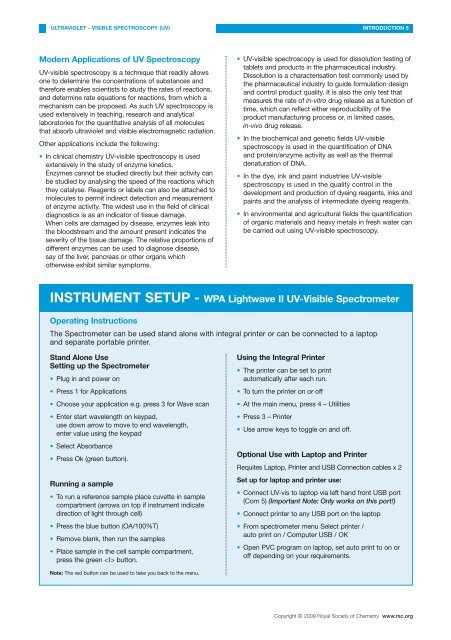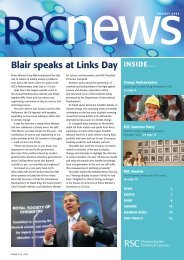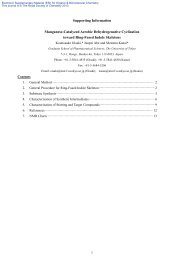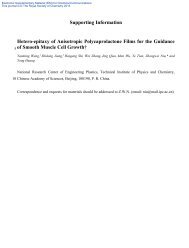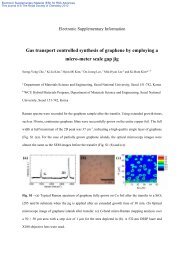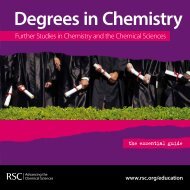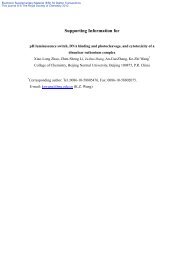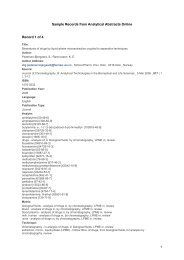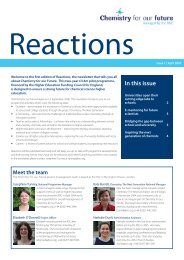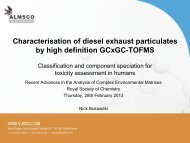Spectroscopy in a Suitcase - Royal Society of Chemistry
Spectroscopy in a Suitcase - Royal Society of Chemistry
Spectroscopy in a Suitcase - Royal Society of Chemistry
You also want an ePaper? Increase the reach of your titles
YUMPU automatically turns print PDFs into web optimized ePapers that Google loves.
ULTRAVIOLET - VISIBLE SPECTROSCOPY (UV)<br />
INTRODUCTION 5<br />
Modern Applications <strong>of</strong> UV <strong>Spectroscopy</strong><br />
UV-visible spectroscopy is a technique that readily allows<br />
one to determ<strong>in</strong>e the concentrations <strong>of</strong> substances and<br />
therefore enables scientists to study the rates <strong>of</strong> reactions,<br />
and determ<strong>in</strong>e rate equations for reactions, from which a<br />
mechanism can be proposed. As such UV spectroscopy is<br />
used extensively <strong>in</strong> teach<strong>in</strong>g, research and analytical<br />
laboratories for the quantitative analysis <strong>of</strong> all molecules<br />
that absorb ultraviolet and visible electromagnetic radiation.<br />
Other applications <strong>in</strong>clude the follow<strong>in</strong>g:<br />
• In cl<strong>in</strong>ical chemistry UV-visible spectroscopy is used<br />
extensively <strong>in</strong> the study <strong>of</strong> enzyme k<strong>in</strong>etics.<br />
Enzymes cannot be studied directly but their activity can<br />
be studied by analys<strong>in</strong>g the speed <strong>of</strong> the reactions which<br />
they catalyse. Reagents or labels can also be attached to<br />
molecules to permit <strong>in</strong>direct detection and measurement<br />
<strong>of</strong> enzyme activity. The widest use <strong>in</strong> the field <strong>of</strong> cl<strong>in</strong>ical<br />
diagnostics is as an <strong>in</strong>dicator <strong>of</strong> tissue damage.<br />
When cells are damaged by disease, enzymes leak <strong>in</strong>to<br />
the bloodstream and the amount present <strong>in</strong>dicates the<br />
severity <strong>of</strong> the tissue damage. The relative proportions <strong>of</strong><br />
different enzymes can be used to diagnose disease,<br />
say <strong>of</strong> the liver, pancreas or other organs which<br />
otherwise exhibit similar symptoms.<br />
• UV-visible spectroscopy is used for dissolution test<strong>in</strong>g <strong>of</strong><br />
tablets and products <strong>in</strong> the pharmaceutical <strong>in</strong>dustry.<br />
Dissolution is a characterisation test commonly used by<br />
the pharmaceutical <strong>in</strong>dustry to guide formulation design<br />
and control product quality. It is also the only test that<br />
measures the rate <strong>of</strong> <strong>in</strong>-vitro drug release as a function <strong>of</strong><br />
time, which can reflect either reproducibility <strong>of</strong> the<br />
product manufactur<strong>in</strong>g process or, <strong>in</strong> limited cases,<br />
<strong>in</strong>-vivo drug release.<br />
• In the biochemical and genetic fields UV-visible<br />
spectroscopy is used <strong>in</strong> the quantification <strong>of</strong> DNA<br />
and prote<strong>in</strong>/enzyme activity as well as the thermal<br />
denaturation <strong>of</strong> DNA.<br />
• In the dye, <strong>in</strong>k and pa<strong>in</strong>t <strong>in</strong>dustries UV-visible<br />
spectroscopy is used <strong>in</strong> the quality control <strong>in</strong> the<br />
development and production <strong>of</strong> dye<strong>in</strong>g reagents, <strong>in</strong>ks and<br />
pa<strong>in</strong>ts and the analysis <strong>of</strong> <strong>in</strong>termediate dye<strong>in</strong>g reagents.<br />
• In environmental and agricultural fields the quantification<br />
<strong>of</strong> organic materials and heavy metals <strong>in</strong> fresh water can<br />
be carried out us<strong>in</strong>g UV-visible spectroscopy.<br />
INSTRUMENT SETUP - WPA Lightwave II UV-Visible Spectrometer<br />
Operat<strong>in</strong>g Instructions<br />
The Spectrometer can be used stand alone with <strong>in</strong>tegral pr<strong>in</strong>ter or can be connected to a laptop<br />
and separate portable pr<strong>in</strong>ter.<br />
Stand Alone Use<br />
Sett<strong>in</strong>g up the Spectrometer<br />
• Plug <strong>in</strong> and power on<br />
• Press 1 for Applications<br />
• Choose your application e.g. press 3 for Wave scan<br />
• Enter start wavelength on keypad,<br />
use down arrow to move to end wavelength,<br />
enter value us<strong>in</strong>g the keypad<br />
• Select Absorbance<br />
• Press Ok (green button).<br />
Runn<strong>in</strong>g a sample<br />
• To run a reference sample place cuvette <strong>in</strong> sample<br />
compartment (arrows on top if <strong>in</strong>strument <strong>in</strong>dicate<br />
direction <strong>of</strong> light through cell)<br />
• Press the blue button (OA/100%T)<br />
• Remove blank, then run the samples<br />
• Place sample <strong>in</strong> the cell sample compartment,<br />
press the green button.<br />
Us<strong>in</strong>g the Integral Pr<strong>in</strong>ter<br />
• The pr<strong>in</strong>ter can be set to pr<strong>in</strong>t<br />
automatically after each run.<br />
• To turn the pr<strong>in</strong>ter on or <strong>of</strong>f<br />
• At the ma<strong>in</strong> menu, press 4 – Utilities<br />
• Press 3 – Pr<strong>in</strong>ter<br />
• Use arrow keys to toggle on and <strong>of</strong>f.<br />
Optional Use with Laptop and Pr<strong>in</strong>ter<br />
Requites Laptop, Pr<strong>in</strong>ter and USB Connection cables x 2<br />
Set up for laptop and pr<strong>in</strong>ter use:<br />
• Connect UV-vis to laptop via left hand front USB port<br />
(Com 5) (Important Note: Only works on this port!)<br />
• Connect pr<strong>in</strong>ter to any USB port on the laptop<br />
• From spectrometer menu Select pr<strong>in</strong>ter /<br />
auto pr<strong>in</strong>t on / Computer USB / OK<br />
• Open PVC program on laptop, set auto pr<strong>in</strong>t to on or<br />
<strong>of</strong>f depend<strong>in</strong>g on your requirements.<br />
Note: The red button can be used to take you back to the menu.<br />
Copyright © 2009 <strong>Royal</strong> <strong>Society</strong> <strong>of</strong> <strong>Chemistry</strong> www.rsc.org


